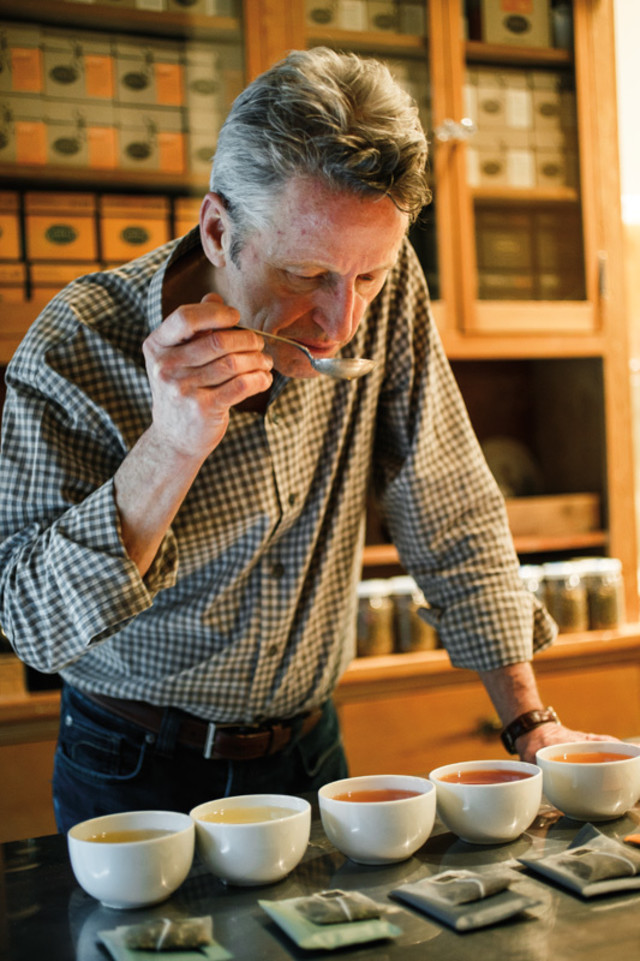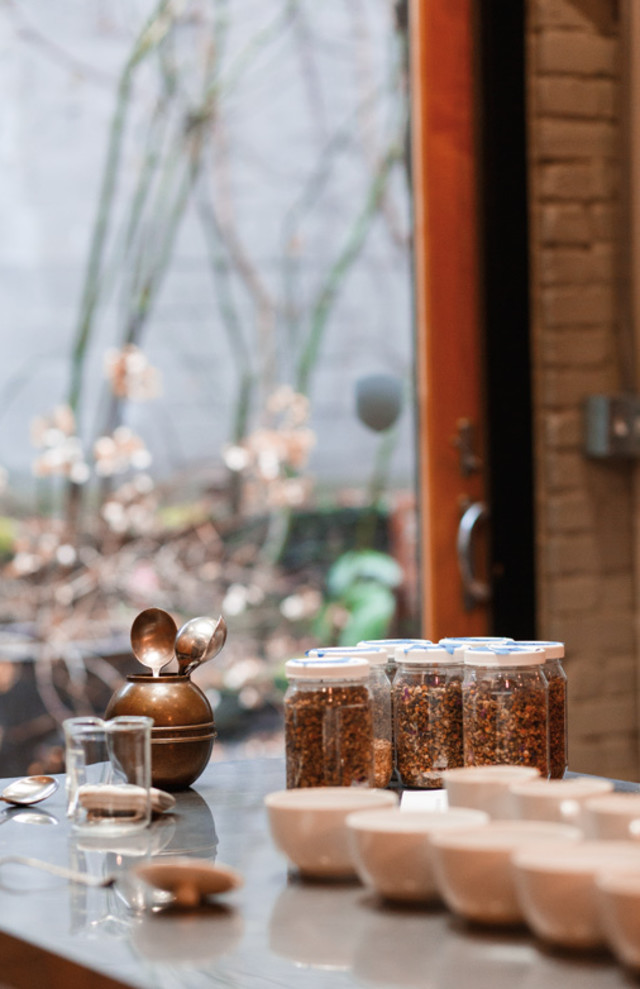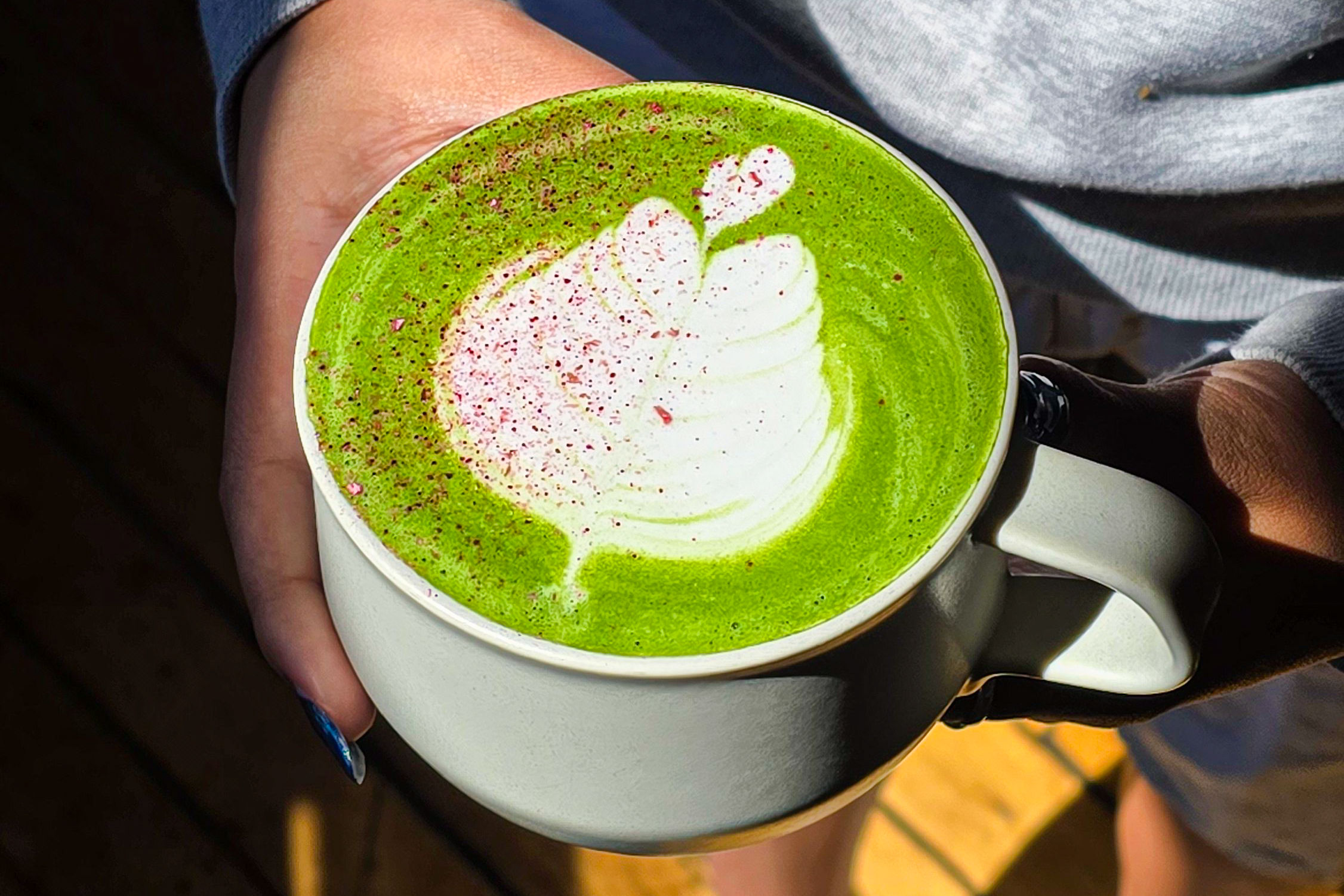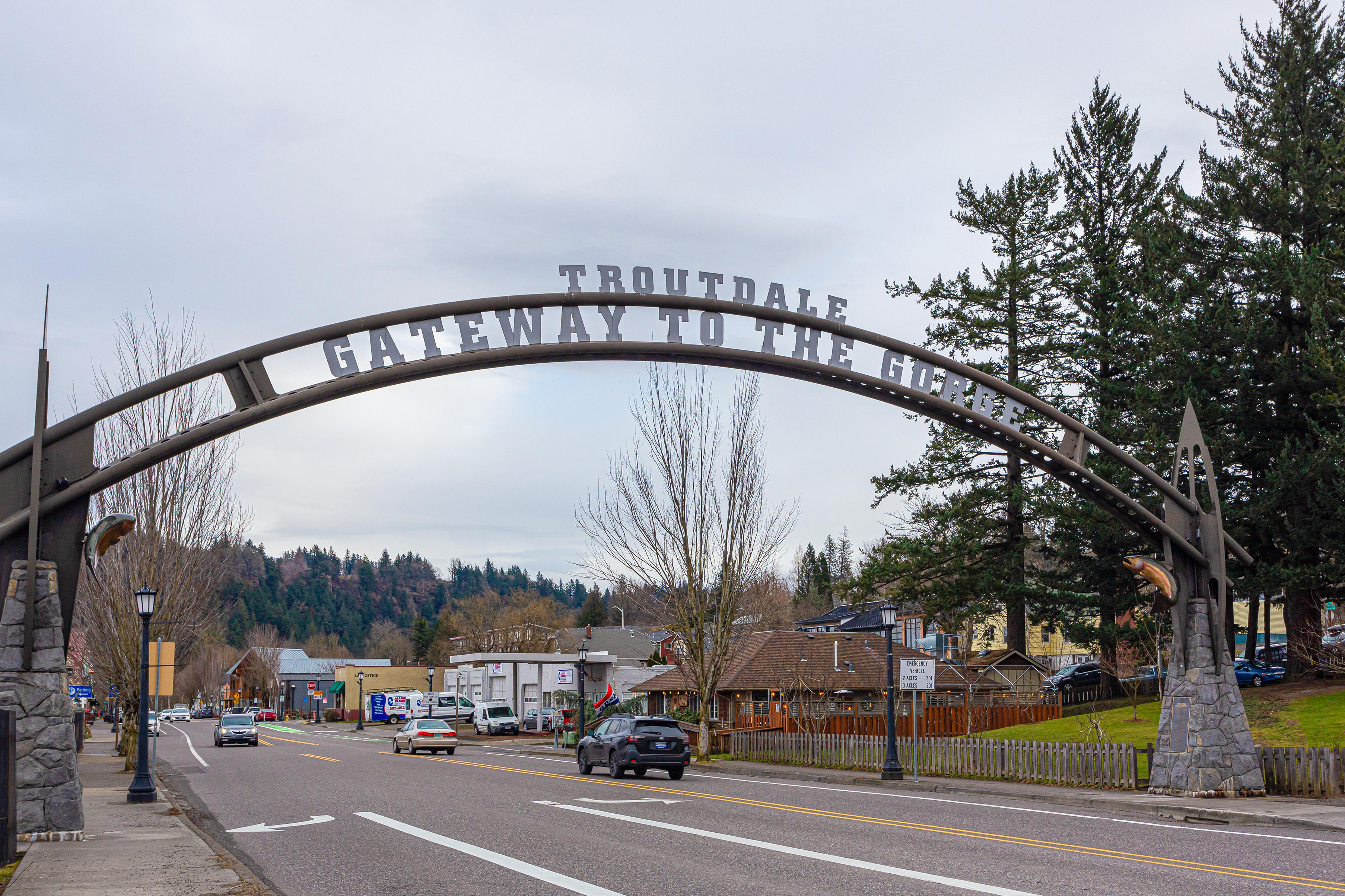The Story Behind Steven Smith's Obsession with Tea

Image: Stuart Mullenberg
The sign on the frosted door reads “Teamakers Only.” Behind it, Tony Tellin, head buyer at Steven Smith Teamaker, prepares samples of first-flush Darjeeling. Within the tea world, the year’s first crop of leaves from the Indian region carries prestige comparable to a Champagne vintage, and fetches up to $100 a kilogram. Tellin steeps the coveted varietal in a long row of filter-equipped teacups and tips them forward, one by one, draining them into large mugs for drinking. (The process vaguely recalls the tableware dance routine from the “Be Our Guest” sequence in Disney’s Beauty and the Beast.) With a sommelier’s confidence, Tellin sucks down a mug “to aerate the aroma compounds,” and spits into an ornate copper spittoon. “Apricot, bright, green, floral.”
Three weeks and 100 samples later, Tellin finally chooses two Darjeelings for Smith’s popular No. 47 Bungalow tea, one of nearly 80 house blends that have made the five-year-old company one of Portland’s hottest culinary exports and one of the country’s leading high-end tea brands.
In the bare-bones laboratory at Smith’s ivy-coiled brick headquarters on NW Thurman Street, some of the rarest teas in the world land on two stainless steel tables for evaluation. Depending on the specific origin and type of tea he’s analyzing, Tellin has as little as 48 hours to choose and then negotiate a price for the key ingredients that will supply the company for the rest of the year. Smith Tea competes primarily with boutique domestic companies, like California’s Mighty Leaf, and gilded international brands like Mariage Frères and Kusmi—Parisian tea houses that date back to the reign of Louis XIV, with blends that sell for up to $25 a box. Smith’s top-tier products make a relatively small splash in the mainstream tea industry, which is dominated by the likes of Lipton and Twinings. Tellin acquires 16 metric tons of tea a year; bigger brands might buy 100 times as much. But bidding skirmishes aren’t unheard of: he once bid a record-breaking $1,500 a kilo (about $3,300 a pound) to beat out all comers for a first-flush Darjeeling.
The company’s owner, Steven Smith —a willowy, silver-haired 65-year-old—launched Stash Tea in 1972. He harbored fond, Proust’s-madeleine-style memories of his grandmother’s sweet Red Rose tea, brewed on rainy days at her Southeast Portland home. More to the point, tea seemed like a path into a particular post-’60s cultural movement. Smith was coming out of the navy after serving in Vietnam when a friend in Portland told him he was starting a business called Sunshine Natural Foods, tapping into the era’s budding interest in organics and homespun flavors. “It was 1971, and I wanted to be part of that scene,” Smith remembers. “It was cool.”
He marketed handmade wooden boxes of Stash sachets via mail order so successfully that the start-up company’s demand for mint kick-started that herb as an industrial-scale crop in Oregon and Washington. In 1993, Smith sold Stash to a 300-year-old Japanese company. The very next year, he launched Tazo Tea in his kitchen, formulating high-end blends—“Zen,” a green Moroccan mint, or “Awake,” a black, English Breakfast–style tea—that sold for $4.49 a box, unprecedented in an American market that had never seen a price tag higher than $2 for a box of tea. Tazo pushed this product with a marketing campaign that Smith describes as “a little Raiders of the Lost Ark, Merlin, and Marco Polo,” featuring imaginary mythologies and new age humor. In 1999, Starbucks bought Tazo for $9 million. Smith stayed for seven years before retiring to Southern France.
Two years before the Starbucks sale, a 21-year-old Tellin stumbled across the loading dock at Tazo’s main warehouse at SE Division Street and Eighth Avenue. Tellin had relocated to Oregon from Iowa, where he’d built fire hydrants for a living, the previous day. He was lost in industrial Southeast, on his way to a temp agency. He knew nothing about tea, but wandered in anyway and convinced the warehouse manager to hire him to move boxes. Smith somehow intuited that this interloper off the street could be useful in other ways. “I needed someone who could take a bicycle apart all the way down,” Smith recalls, “and then put it back together in his sleep. I needed someone that detail oriented to help me run my tea business. Hopefully, I could also teach this person to taste tea. That was Tony.”
Slowly, Tellin worked his way up from the loading dock to Tazo’s tasting laboratory. “I would prepare hundreds of tea samples for Steve to taste every week,” he remembers. “Later, as I was cleaning, I would sneak a taste of everything he had tried to figure out his palate. At the time, he was into really assertive teas, like strong, malty Assam.” In 2004, Tellin was promoted again, this time to tea buyer for the company, now owned by the Seattle coffee goliath. In that role, he traveled to Sri Lanka and India, battling the Lipton-scale power players for the best price on 300 tons of tea.

Image: Stuart Mullenberg
Meanwhile, Smith found that retirement didn’t suit him. During his yearlong sojourn in France, he became fascinated with provenance, or an ingredient’s origin, taking a cue from the winemakers of France’s Rhône Valley. In 2009, he bought a former blacksmith’s shop in the shadow of the Fremont Bridge and launched Steven Smith Teamaker, his third tea brand.
The new company’s smartly crafted, black-framed boxes are so steeped in provenance that each carries a batch number to be cross-referenced on the Smith website for exacting information on every ingredient tucked into that particular flavor’s sachet. “It seems a little bit Portlandia now, but I was ahead of the curve—nobody in the tea business was doing it,” says Smith.
Soon after the company’s inception, Tellin bolted from Tazo and joined Smith as a partner. “The beauty of Smith Tea is that we pay more attention locally, to what House Spirits is doing, or Olympic Provisions, or Salt and Straw, than we do our competitors,” Tellin says. “They are our inspiration.” By luxury tea standards, Smith takes a risky, unorthodox approach. “A lot of what we do here doesn’t make any sense from the outside . It’s the kind of stuff Tazo would call ‘unscaleable,’” says Smith, referring to his recent experiments scenting teas in whiskey, bourbon, and rum barrels, and creating a Portland-cool smoked tea.
Even so, the company, which employs a crew of about 30, is already worth roughly half of Tazo’s value before it was sold to Starbucks, according to Smith. It’s found on shelves in more than 2,000 stores nationwide, including Williams-Sonoma, Sur La Table, and Whole Foods, and is garnering an international reputation among tea elite across Europe, Asia, and Canada in a way that Tazo never did.
Tea testing is a time-sensitive affair. Every tea plant is the same species, Camellia sinesis, but even plants harvested the same day on the same estate can vary greatly in flavor. Darjeelings plucked an hour or two earlier or later, from a shady or sunny part of the same Sri Lankan hillside, will sell for a different price. Once Tellin secures a leaf he wants to try, the company’s production manager creates an initial batch. Then a team of 16 teamakers compares that specimen against an archived library of blends, cross-examining leaf size, liquor (steeped tea water), and flavor notes, adding or subtracting bergamot oil or chamomile petals to meet the Smith ideal.
Once purchases are made, building blends—the formulae that fill the company’s elegant mesh sachets—from scratch is a ritual reserved for Smith and Tellin alone. Smith says he hopes he’ll one day pass the torch, along with his hard-earned connections, to his understudy.
Tellin describes his priority as quality over quantity—which, strategically, requires building relationships more than outbidding the industry’s major players. Steven Smith’s sources range from tiny, family-owned farms in Egypt to large factories in China fueled by 10,000 laborers. Still, Tellin says, he and/or Smith have visited every farm they buy from in person. “When Mohan Chirimar, a tea trader and broker in Calcutta, comes to the United States, his family stays at my house,” Tellin says. “His children, too. They are friends first and suppliers second.” After Smith’s three decades of building relationships across a web of international tea plantations, suppliers come to him, motivated both by professional loyalty and his new brand’s emerging name recognition.
And the tea? The tea is good. No. 39, “Fez,” could convert a longtime coffee addict into a tea drinker. The play on a classic Moroccan mint comes on strong with a wintergreen nose, courtesy of spearmint grown in Eastern and Central Oregon—a happy result of Smith’s earliest tea investments in the 1970s. Next, the body: vegetative, sweet notes of Mao Feng green tea, grown at high altitudes in the mountains of central Zhejiang Province, China. Last, you feel the tickle of lemon myrtle, flown in from the subtropical rain forests of Australia.
That fusion of three continents could be a formula for this company’s emerging success: Smith’s legacy in the tea world, expressed through a fascination with origins and flavors drawn from the places and people that, as Tellin likes to say, “have always been there behind the curtain.”




